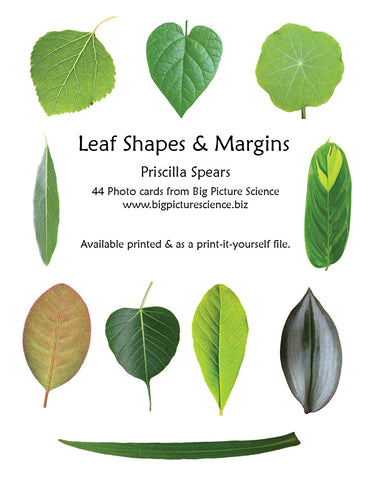Leaves! Leaves! Leaves! (and math, too!) September 09 2015, 0 Comments
With summer nearing the end and fall coming fast, do your thoughts turn to leaves? If so, I’ve got a new card set for you -- Leaf Shapes and Margins. I’ve been collecting photos of leaves for many years. I selected 44 species that show a variety of characteristics and turned the images into cards for the classroom. Each card has a single leaf, sans background, along with its common and scientific name. Here's the card for the aspen leaf. It is half a letter-sized page (5.5 X 8.5 inches) in real life. You can see the details of its venation and the structure of its margin.

While I designed this set for older elementary children to use in leaf shape studies, it can be used by any age for appreciation of the beauty and variety of leaves. It takes math and botany to describe leaf shapes according to the Manual of Leaf Architecture by Beth Ellis, et. al., a highly respected professional botany reference. First one must measure the length of the leaf blade, and then divide it into five equal parts. Next one must find the widest part of the leaf blade and see if it falls within the middle fifth, in the basal two-fifths, or in the two-fifths nearest the apex. That determines elliptic, ovate, and obovate shapes respectively. An oblong leaf has about the same width through the middle one-third of the leaf blade. A linear leaf is at least ten times longer than it is wide. Those are the five major leaf shapes. This more precise system of determining leaf shapes replaces an overwhelming number of loosely defined traditional terms.
Warning – to prevent brain strain, do NOT measure in inches. Use centimeters, and you will appreciate why scientists (and most of the world) use the metric system.
For more math and botany, one can measure the angle of the apex and base of a leaf and decide if these angles are acute, obtuse, or reflex. For the base, there is one more situation, a circular base. The shape of the apex and base are also part of the leaf description. There’s more about this in my book, Plant Lessons: Introducing Children to Plant Form and Function.
Margins can have teeth, lobes, both structures, or neither. There are leaves that show all these situations in the set. The leaves include common trees, such as oaks, maple, and elm, as well as houseplants and weeds. Crabgrass comes in handy when you need a linear leaf. No one minds if you pull it up. The bo tree shows how a drip tip looks, not something you will find in your neighborhood unless you live in a tropical area.
The background information that comes with this new set includes a few sentences about each of the plants whose leaves are shown, a procedure for determining leaf shapes, and a table that gives the description of the leaves so you can check your results.
More than anything, I hope this card set inspires all ages to look more closely at leaves and appreciate the wonderful structures of these food factories for life on Earth.

